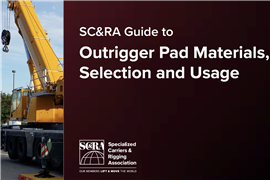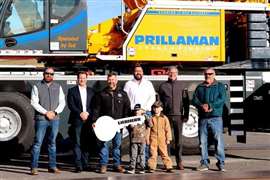Detailing the latest CCO training updates
23 January 2023
CCO continues to assist the industry in meeting industry and OSHA requirements by creating fair, valid, reliable national certifications. National certification ensures that that all individuals have been assessed on the same standardized set of base knowledge and skills relevant to their job.
 The CCO Telehandler Operator program has designations for two types of telehandlers: fixed and rotating.
The CCO Telehandler Operator program has designations for two types of telehandlers: fixed and rotating.
CCO completed development on two operator certifications in 2022: Telehandler and Concrete Pump Operator certifications.
The Telehandler Operator Certification, released just this month, is aimed at helping the industry meet not just OSHA 1926 Subpart CC, but the General Industry rule 1910.178 as well as ANSI/ITSDF B56.6. Between the three standards, operators of telehandlers must be, depending on the equipment and task, certified or evaluated for competency. This certification is the first in the U.S. that meets all three standards and provides the highest level of compliance for employers as well as the greatest flexibility for employees.
The CCO Telehandler Operator program has designations for two types of telehandlers: fixed and rotating. While standard telescopic handlers – also known as “fixed telehandlers”– have boom sections to lift and extend materials for placement, “rotating telehandlers” can lift, extend and swing. This means that rotating telehandlers provide an additional dimension of operation, giving them additional crane-like capabilities that make them more likely to require certification. Currently there are many more fixed telehandlers models in the U.S. than rotating models, but rotating versions have significantly enhanced capabilities, so they are rapidly gaining favor over legacy models.
In order to be compliant with OSHA 1910.178, which requires that an evaluation be conducted at least once every three years, CCO Telehandler certifications are valid for a three-year period.
Given the high volume of telehandler operators in the field – easily topping 280,000 currently and quickly rising – and the machine’s versatility, the expectation is that the industry will move to ensuring safe operators by certifying operators to a national standard. For more information on the Telehandler Operator certification, visit www.nccco.org/tho.
The Concrete Pump Operator program launched mid-2022 testing operators on operation concepts and scenarios as well as industry standards that operators need to know, including ASME B30.27: Material Placement Systems Safety Standard for Cableways, Cranes, Derricks, Hoists, Hooks, Jacks and Slings.
According to the ASME B30.27 standard, operators must pass a written exam that covers a number of operational characteristics including powerline avoidance, stability and emergency control.
The CCO Concrete Pump Operator certification is the only credential available from an accredited certification body and is the most affordable option.
 CCO certification cards include the certificant’s name, CCO ID, photo and a QR code. For more info visit www.nccco.org.
CCO certification cards include the certificant’s name, CCO ID, photo and a QR code. For more info visit www.nccco.org.
Currently, operators certify via a written exam only. This was how the CCO Mobile Crane Operator program was launched until it implemented its first practical exams in 1998. CCO is currently developing the practical portion of the certification, which is expected to launch before the end of 2023. Those who certified without the practical exam will likely take the practical exam at recertification.
For more information on the Concrete Pump Operator certification, visit www.nccco.org/cpo.
Crane operator evaluators
Following publication of OSHA’s Final Rule, Crane and Derricks in Construction in November 2018, crane operator qualification is generally defined as a three-step process: (1) training, (2) certification and (3) evaluation.
For more than 27 years, CCO has provided certification for crane operators in order to increase safety in the industry and provide employers with a baseline by which they can assess operators. However, certification certainly cannot account for all of the elements that go into making an individual qualified to safely operate a particular crane, in a particular configuration, in a particular working environment, to complete a particular task. Hence the need for proper crane operator evaluations, in addition to certification.
Under the Rule, OSHA lays the responsibility squarely on employers to conduct evaluations of operators to ensure they are qualified, by a demonstration of both the knowledge and skills necessary to operate specific equipment configurations safely, and the ability to recognize and avert associated risks.
In general, evaluations are more directly focused on an operator’s ability to perform assigned work as well as the ability to recognize and avert risk, instead of the general knowledge and skills tested during the certification process. OSHA specifically states that the possession of a certificate (or degree) cannot, by itself, cause a person to be qualified for the purposes of the evaluation.
So how does the employer ensure that their crane operator evaluator meet OSHA’s requirements? Currently, there is standard or baseline. This is why CCO is set to develop a credential for crane operator evaluators which will meet the OSHA regulations. By offering this credential, CCO hopes to bring some clarity and uniformity to evaluations, to make evaluations more reliable and defensible and to establish a “gold standard” for the qualification of crane operator evaluators.
CCO has begun accepting applications for the taskforce that will create the certification and anticipates that its Crane Operator Evaluator certificate will be available in early 2024.
What qualifies a rigger?
ASME released an update to standard B30.5 for Mobile and Locomotive Cranes which recently took effect. That standard now states that the presence of a qualified rigger is required any time a mobile crane with a lifting capacity greater than 2,000 pounds is working. Previous versions of the standard only required a qualified rigger during assembly/disassembly or when personnel were in the fall zone.
So, what “qualifies” a rigger? Among other things, the rigger must pass a written and practical exam which tests the following:
- Selection and use of hardware,
- Applications of standard hitches,
- Estimation of load weight, center of gravity, angle and load movement and
- Inspection of equipment
As typical when such updates are released, CCO’s subject matter expert reviewed the updated standard to determine if program or exam updated were warranted. Based on the rigger requirements of ASME, testing for Rigger Level II certification meets testing obligations. CCO Rigger certifications is the only national, publicly available, third-party accredited certification to meet these requirements.
Of course, testing is just one aspect to meeting these requirements. Employers must ensure that the rigger is also “qualified.” Qualification may vary by rigging job. An individual may be qualified for one job, but not for a more complex rigging job. In general, a qualified rigger is someone who, in addition to testing, has:
- A recognized degree, certificate or professional standing,
- Extensive knowledge, training and experience, and
- Successfully demonstrated the ability to solve problems related to rigging a load
In the end, CCO Certification is considered a tool in the toolbox for those attempting to meet rigging standards.

Thom Sicklesteel has served as chief executive officer of CCO since 2019.


